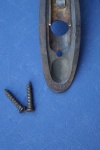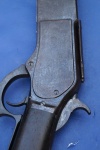
|
Winchester Model 1876 Rifle --Attic Find!-- |
This is a nice early Winchester Model 1876 Rifle that came to us recently in attic condition and has never been in a collection. When the Model 1876 was introduced back at the Philadelphia Exposition in 1876, Winchester dubbed it the "Centennial Model". It is essentially a beefed-up large caliber version of the Model 1873 as it chambered the powerful 45-75, 45-60, 40-60 and 50-95 Express cartridges. These were large early black powder hunting calibers back in the 1870's through the mid-1880's. This is an old-19th century Florida gun. That said, one does not expect to find many large caliber Winchesters in the South as there was very little here in the way of large game. It certainly makes one wonder who owned it and for what purpose? Alligators? This one is a 2nd Model with the screw-on dust cover rail. It's in caliber 45-60 with a standard 28" round barrel, full magazine, and crescent style rifle buttplate. It has a fairly serial number in the 17,000 range which dates its production to the year 1881. There is also a special order feature on this rifle...more on this later as there is still much to talk about! Years ago, we had an early 2nd Model 1873 rifle in 38-40 that was almost identical to this rifle in condition and looks. It too came from Florida and you can really see how the environment a Winchester is kept in over many years can shape its appearance. When we first received it, it had a heavy, crusty brown patina that was so thick that it almost had topography to it. This is fairly common in the South as there is a lot of heat and humidity which turns the metal brown. In contrast, these conditions seem nearly ideal for the wood as the humidity keeps the wood from drying out. As brown as it looked, this rifle had really sharp edges and markings indicating that it was not used a great deal. There was also something really unusual about this gun. We could see little specks of original blue shining here and there around the sideplates and down in the corners. After wetting a pencil eraser in some alcohol and rubbing a little area around it, we noticed that more speckled shiny original blue began to reveal itself. Well, this really got intriguing! You don't expect to find blue under such a heavy patina but there it was...and more and more kept showing up. One theory we came up with is that it was kept in a house where someone was a heavy tobacco smoker. The soot may have shielded some of the metal and protected the blue. How much original blue was down there? One thing I've learned over the years of collecting is that "being in a hurry" rarely yields positive results. I took my time...and tried to spend a few quiet hours per week but the results were worth it. It took three months going inch by inch carefully rubbing away the layers of brown nicotine, smoke, dirt, dried grease, and specks of surface rust. In the end, there were some light pits but it turned out that there was A LOT of original blue left on this rifle! Now it is not strong blue as it's mixed with patina but it's there. We even found what appears to be an old fingerprint (probably from the original 19th century owner of this rifle) in the original blue just forward of the trigger. See photo. Special Order Feature. This was another unexpected but welcome little surpise. Being an early Winchester, this rifle was hand-fitted by workmen who applied assembly numbers to aid in the final assembly after finishing. We removed the stock to verify that it had matching assembly numbers on the upper inlet of the stock, lower tang of the frame, and under the toe of the buttplate. They matched perfectly BTW. See photos. However, when we checked for the assembly number on the lower tang, we noticed the letters "F X" by the number. Standard rifles will not have these letters but special order guns will often have these codes for extra features. "X, XX, XXX, or XXXX" denote higher than standard grades of walnut. The F and X would denote either special order "Extra Figured" walnut or 1X burl walnut. We didn't notice the fancier wood at first because the original varnish has turned to such a deep reddish brown, that it's hard to see...but upon closer inspection, there are indeed some very tight grain patterns towards the rear of the stock. Condition-wise, this 1876 grades to NRA Antique Fine Condition. There is 50% thinning original blue on the frame that is mixed with patina and some scattered light corrosion in a few places. The really amazing thing to us is how much blue there is in the high spots which would be the most prone to wear. While the blue is not strong, it shows up on over 90% of the surface area on the receiver indicating this rifle was probably near pristine when it was put away. Loading port shows much of the original fire blue which is a little dull from age but nice. The hammer shows some mottled original case colors mixed with patina and there is a bit of silvered out case remaining on the lever profile which has otherwise turned to patina. The brass loading block is as good as they come...uncleaned dark butterscotch patina with the most perfect marbled crystal lattice you will ever see along with a crisp "45-60" caliber marking. The barrel shows about 60% original blue with the balance turned to patina. Forend cap shows 40-50% speckled original blue remaining. The magazine tube has turned mostly brown with some scattered pits towards the front and just beneath the barrel. The wood is completely untouched with 75% original varnish remaining that has turned an almost opaque deep mahogany red from age. There are no chips, or cracks and the wood to metal fit is perfect. If you look closely at the photos, you will see a few little specks of old paint on the wood from where it sat in a closet or on a wall for many years as rooms were painted. This can be removed but these little specks of old paint often serve as a seal of authenticity to collectors who like attic condition guns. Last but not least, this 1876 has a great action and an Fine+ bore with strong lands and grooves that are still fairly bright and if desired, should clean quite easily up to Excellent. All in all, this has been one of the neatest Winchesters we've found in a long time. Although, they are few and far between, it's experiences like this that are what got me into collecting and have kept me going for over thirty years. Item# 1844 SOLD |
 |
 |
 |
|
 |
 |
 |
|
 |
 |
 |
 |
 |
 |
||
 |
 |
 |
|
 |
 |
 |
 |
 |
 |
 |
 |
 |
 |
 |
 |
 |
 |
 |
 |
 |
 |
 |
 |
 |
 |
 |
 |
 |
 |
||
 |
 |
 |
 |
 |
 |
 |
 |
 |
 |
 |
 |
 |
 |
 |
 |